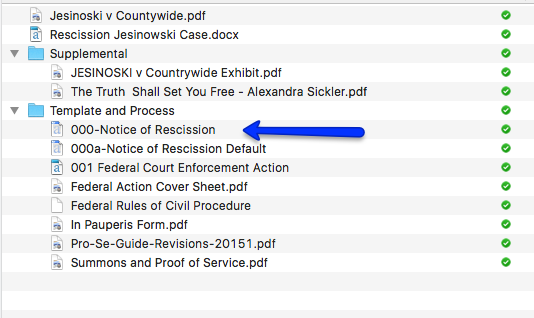Foreclosure Defense: Module 0.1
Right of Rescission Procedure
Under the Truth in Lending Act (TILA) also known as FDIC Regulation Z: USC TITLE 15 > CHAPTER 41 > SUBCHAPTER I > Part B > § 1635, called The Right of Rescission, you have the right to rescind your loan. If you are within 3 years of the closing of your loan or if you have discovered new evidence of any TILA/RESPA violations, then you can notify your lender of your intention to rescind your loan.
You can only do this if this is your primary residence. Sorry, if you are an investor and these are rental properties, then this does not apply to you.
IMPORTANT POINTS TO UNDERSTAND ABOUT THIS PROCESS:
1) This must be your primary residence.
2) Your bank has to notify you within 20 days, otherwise, they forever lose their opportunity to object.
3) You can do this regardless if your loan is more than 3 years old.
Here are the benefits:
1) YOU GET ALL THE MONEY YOU’VE EVER PAID INTO THE LOAN BACK!!!! Of course, taxes and insurance does not count. If you are paying $2000 per month for the last 3 years, then that is $24,000 per year….which adds up to be a nice $73,000 in one lump sum check. Not bad…
2) You will not have a default on your credit report. You never had the loan. It was a faulty loan.
On the down side, you will have to move out of your home. Look, let’s look at it this way. If you were going to lose your home anyway, why not force the bank to take your home back and give you all the money back. This means you will have lived in that house for X years…FOR FREE!!! And now you have a large lump sum CASH to move into your new home.
If you are interested in this process, simply write a letter to your “lender”. Title the letter “Notice of Rescission of Loan”. Please see instructions below.
Here’s the kicker.
They are required to respond in 20 days.
If you tender your home at the rescission and if they do not respond within 20 days of tender, then they lose their security
Don’t believe me? Check this out:
” USC TITLE 15 > CHAPTER 41 > SUBCHAPTER I > Part B > § 1635
(b) Return of money or property following rescission
When an obligor exercises his right to rescind under subsection (a) of this section, he is not liable for any finance or other charge, and any security interest given by the obligor, including any such interest arising by operation of law, becomes void upon such a rescission. Within 20 days after receipt of a notice of rescission, the creditor shall return to the obligor any money or property given as earnest money, down payment, or otherwise, and shall take any action necessary or appropriate to reflect the termination of any security interest created under the transaction. If the creditor has delivered any property to the obligor, the obligor may retain possession of it. Upon the performance of the creditor’s obligations under this section, the obligor shall tender the property to the creditor, except that if return of the property in kind would be impracticable or inequitable, the obligor shall tender its reasonable value. Tender shall be made at the location of the property or at the residence of the obligor, at the option of the obligor. If the creditor does not take possession of the property within 20 days after tender by the obligor, ownership of the property vests in the obligor without obligation on his part to pay for it. The procedures prescribed by this subsection shall apply except when otherwise ordered by a court. “
Action Steps
Step 1.
Download and Read the Supreme Court Case: Jesinoski v Countywide.pdf
Step 2.
Read the article written by Niel Garfield. “Rescission Jesinowski Case.docx” (after you have downloaded and unzipped the document – See Step 1)
Step 3.

Open “000-Notice of Rescission”. Customize it.
Step 4.
Send it to your Servicer using Certified Mail, Return Receipt.
Step 5.
Wait 20 days.
If your Servicer reply within 20 days letting you know that you do not qualify for Rescission and stating a valid reason…like you are outside of the Statute of Limitation of 3 years, then unfortunately, you’re done.
If they do not respond within 20 days, then you win. See Step 6.
Step 6.
Open and read, then customize “001 Federal Court Enforcement Action”. Obviously, you will want to remove all the instructions from the top of the document.
Step 7.
Fill out the Federal Action Cover Sheet.
Fill out the “In Pauperis Form.pdf” form…so you can file your action for free in Federal Court.
Step 8.
Read “Federal Rules of Civil Procedure”
Step 9.
Look up the address of your servicer in the State where they are incorporated. Go to the Corporate Division of your Secretary of State website. Use Google, for example “California Secretary of State Corporate Division”. Look up the name of your Servicer. Get their Registered Agent address.
Step 10.
Fill out the Summons and Proof of Service.
Step 11.
File Your Action in your local FEDERAL DISTRICT COURT. Get a Case #, and write it onto the other copies.
Serve the Copy of the Action to the Servicer’s Registered Agent address.
Remember: What you give to the court, you must always give to the other side.
Disclaimer:
This is purely for educational purpose. Nothing on this site can be construed as giving legal advice. You are using this information at your own risk. You are to seek legal counsel in these matters.
